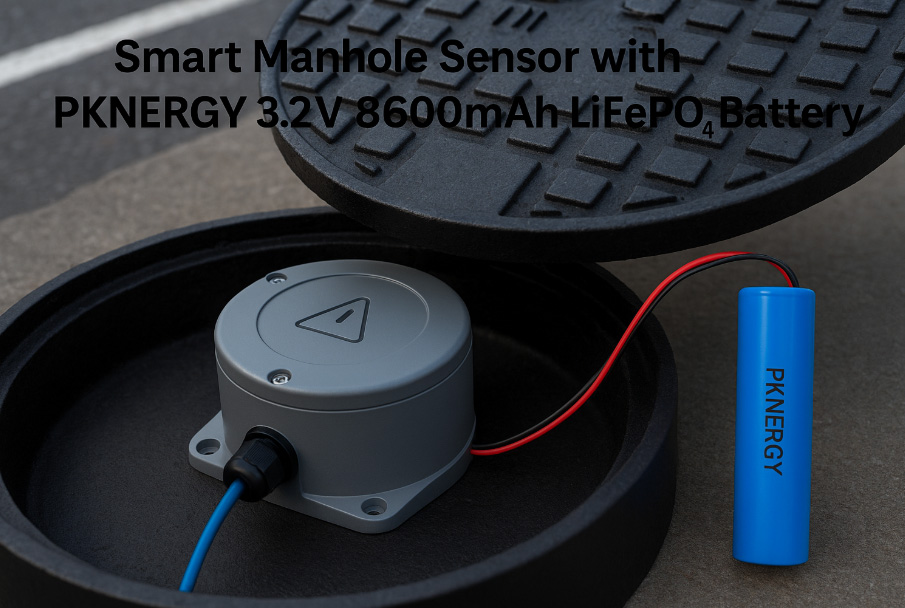Stable, safe, and long-lasting power for underground monitoring — lid displacement, water ingress, and unauthorized access.
As smart cities scale up, municipal infrastructure monitoring must be safe, reliable, and maintenance-light. Smart manhole sensors operate underground in humid, hard-to-access locations — their power systems need multi-year endurance, wide temperature tolerance, and safe pulse discharge for wireless communications. PKNERGY’s 3.2V 8600mAh LiFePO4 solution meets these demands for long-term urban IoT.
Market Trend & Technical Requirements
- Service life: multi-year runtime, >2000 cycles design target
- Temperature: −20 °C ~ +70 °C underground environments
- Pulse discharge: up to ~5A peak for NB-IoT / LTE-M / LoRa bursts
- Low self-discharge: <2%/month to support long standby
- Safety: LiFePO4 chemistry with excellent thermal stability
Typical Battery Configuration
Key Specifications
- Nominal Voltage: 3.2 V
- Rated Capacity: 8600 mAh
- Continuous Discharge: ~2 A
- Peak Discharge: ~5 A (communication burst)
- Cycle Life: >2000 cycles
- Operating Temp: −20 °C ~ +70 °C
- Self-discharge: <2% per month
Pairs well with low-power NB-IoT to achieve ~3–5 years operation depending on transmission duty cycle.
Integration Notes
- Low-power BMS/PCM with deep-sleep & timed wake
- IP67/IP68 enclosure, conformal coating, anti-corrosion terminals
- Optional comms: CAN / RS485 / UART to host firmware
- State-of-charge model tuned for long standby windows
Explore PKNERGY engineering: pknergy.com · See LiFePO4 series on pknergybattery.com
Performance Comparison
| Parameter | PKNERGY LiFePO4 (3.2V 8600mAh) | Li-SOCl2 (Primary) | NMC Li-ion |
|---|---|---|---|
| Rechargeable | ✅ Yes | ❌ No | ✅ Yes |
| Cycle Life | >2000 cycles | Single-use | ~500–800 cycles |
| Temperature Range | −20 °C ~ +70 °C | −40 °C ~ +85 °C | −10 °C ~ +60 °C |
| Safety | Excellent (no thermal runaway) | Good | Moderate |
| Maintenance | Rechargeable; field-friendly | Replace-only | Rechargeable |
| Environmental Impact | Low (recyclable) | Moderate | Moderate |
Engineering Insights
- Duty-cycle modelling to align SoC window with reporting intervals
- Peak-current provisioning for radio TX bursts with IR margin
- Thermal & humidity mitigation (potting, gasketed enclosure)
- Sleep-mode current at μA-level where feasible; brown-out protection
PKNERGY Custom Battery Solutions
- Precision cell matching & pack balancing
- Low-power BMS with sleep/wake, tamper detection
- Comms: CAN / RS485 / UART
- IP67/IP68 mechanical design for harsh environments
- Compliance: UN38.3, IEC62133, CE, UL
Explore:
PKNERGY OEM/ODM ·
LiFePO4 Batteries ·
Custom Packs
FAQ
How long can one cell last in the field?
With NB-IoT at low reporting frequency, designs typically target 3–5 years per deployment; actual runtime depends on payload, signal quality, and temperature.
Why LiFePO4 instead of primary Li-SOCl2?
LiFePO4 is rechargeable, safer (no thermal runaway), and lowers total ownership cost with easier maintenance across large fleets.
Can you provide IP68 battery enclosures?
Yes. We design gasketed, potted assemblies with corrosion-resistant terminals and pressure-equalization options.
What certifications are available?
UN38.3 for transport, IEC62133/CE/UL per project needs. We supply test plans and documentation.
Next Step
Share sensor duty cycle (tx interval), radio type, ambient temperature, allowable volume, and target lifetime. We’ll propose a battery configuration within one working day.
- Talk to Miah for OEM/ODM
- Or visit pknergy.com for engineering support
Contact Cassie — PKNERGY
For smart city IoT battery projects, OEM/ODM and rapid prototyping.
Email: sale@pknergy.com | Website: pknergy.com
Post time: Nov-04-2025


